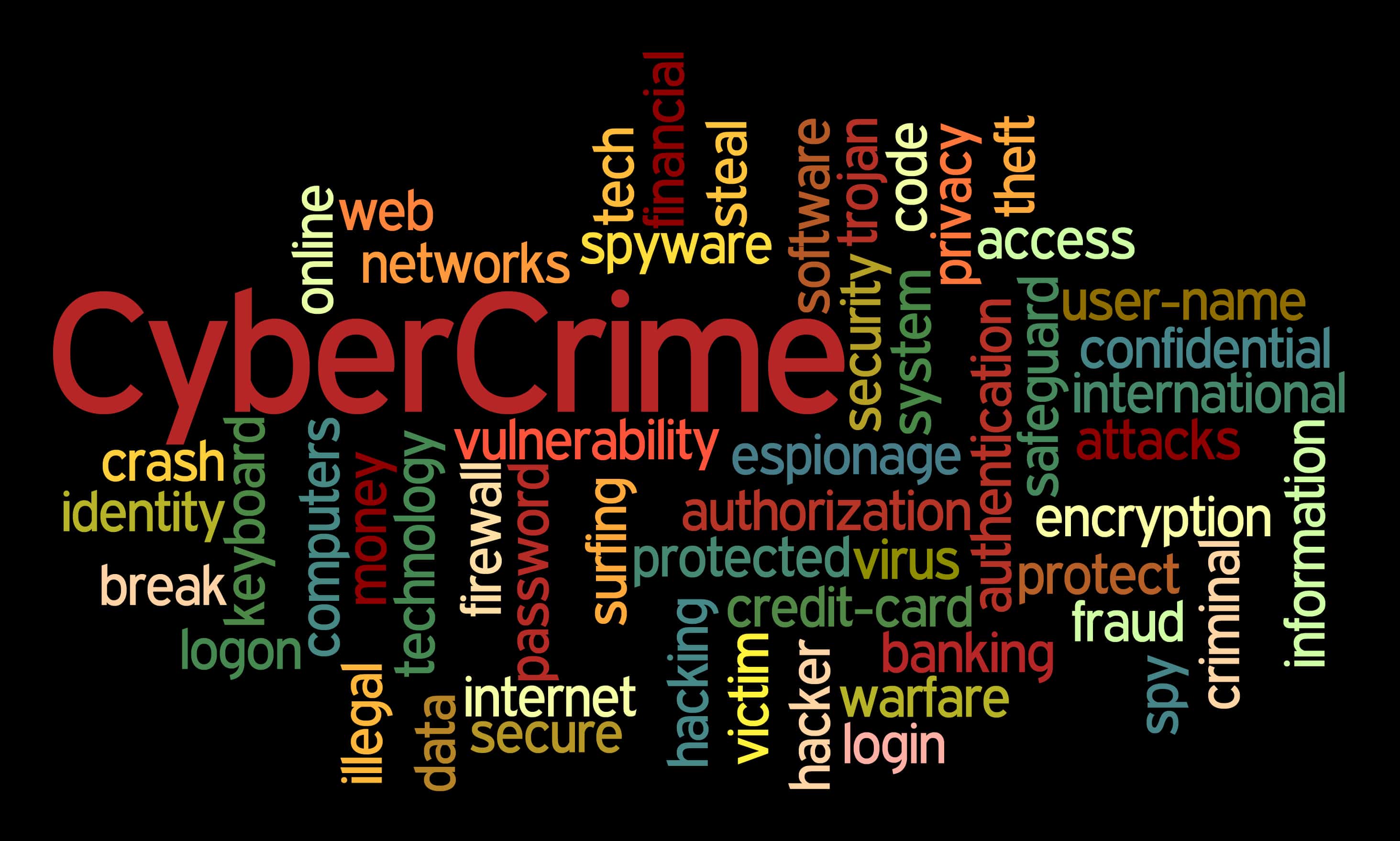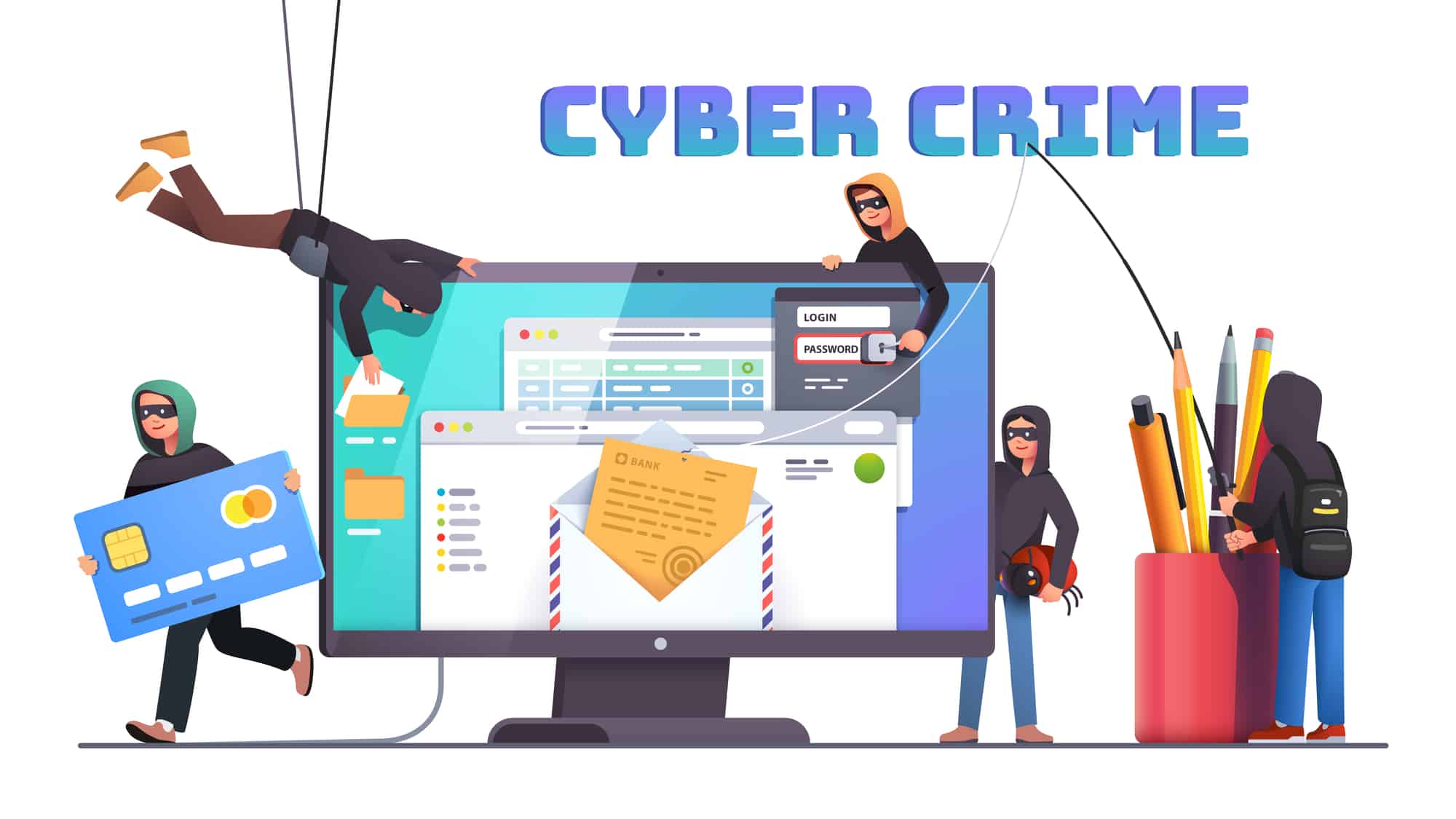
Cybercrime is increasing rapidly nowadays. The terminology used to describe it is evolving accordingly. By knowing them, you can protect yourself, your family, and your business from any illegitimate access to your computers, networks, or networked devices. Additionally, you will prevent any online attacks. In this article, we will provide you with the industry’s most significant and commonly used cybercrime terminology.

What is Cybercrime?
Cybercrime is any criminal activity that uses or targets computers, networks, and networked devices. Cybercriminals use these tools to commit their nefarious activities, such as trafficking in child pornography and committing fraud. They also target computers, networks, and networked devices to steal personal and financial information, block data and ask for ransom, and many other illegal activities.
Cybercrime Terminology
Since cybercrime is evolving, it is important to know the most common cybercrime-related definitions and terms. This will allow you to easily detect any online attacks and quickly fight them. Furthermore, this will help you prevent cybercrime and keep your devices and networks safe. So here is the most important cybercrime terminology.

Cybercrime Terminology Beginning With the Letter B
The following are the most significant cybercrime terms that begin with the letter B.
Back Door
Back door is a method that bypasses some or all security mechanisms, enabling access to a computer system, software, and network.
Biometrics
Biometrics is the measurement of physiological characteristics, such as fingerprints, facial features, iris patterns, or voice patterns, to identify an individual user.
Blog
Short for weblog, a blog is an online journal posted on a web page.
Black Hat
A black hat or a black hat hacker is sometimes called crackers. With malicious intent, s/he is a hacker who breaks into computer systems and violates laws, confidentiality, and computer security. His/her purpose is to destroy files, steal personal or financial information, and hold sensitive data and ask for a ransom to decrypt it. S/he uses his/her hacking skills for financial gain or out of malice.
Bot
A bot is a software robot on the internet or another network that performs automated tasks. It can interact with users or systems.
Browser
A browser is a computer programme with a graphical user interface that provides a way to display, navigate, and interact with all the information on the World Wide Web, including web pages, images, and videos.
Bypass
In computing, bypass means a flow in a security system that allows hackers to avoid security mechanisms to get unauthorised access to a system or a network.
Cybercrime Terminology Beginning With the Letter C
Here is the most common cybercrime terminology that begins with the letter C.
Ciphertext
Ciphertext or cyphertext is encrypted or encoded information. It results from using an encryption algorithm called Cipher, which is unreadable by a human or a computer system, on any plaintext.
Computer Emergency Response Team (CERT)
A Computer Emergency Response Team (CERT) is an organisation with a group of IT experts. These experts detect and respond to an organisation’s cybersecurity incidents. They also collect and distribute information about security breaches.
Cookie
A cookie is an information packet sent from a website and stored on a web browser. It records all the user’s browsing activities; it contains information about how the user uses the website.
Countermeasure
A countermeasure is an action, process, system, or device that prevents threats or mitigates their effects on a computer, network, or server.
Cracking
Cracking is the process of trying to break into a secured computer system and overcome a security measure to damage, steal, or illegitimately view data. The cracker is the hacker who performs this malicious action.
Cryptography
Also known as cryptology, cryptography is the practice and study of secure communications techniques. Before sending it over a public network, cryptography protects information or hides its meaning by converting it into a secret code. Thus, it allows only the sender and the intended recipient to view the content.
Crypto Key
A key in cryptography is an encryption system consisting of a string of characters, whether numbers or letters. Within an encryption algorithm, it alters data to appear random. Only the sender and the receiver can read the messages as this key encrypts (locks) and decrypts (unlocks) them.
Cybercrime Terminology Beginning With the Letter D
The common cybercrime terminology that begins with the letter D is as follows.
Dark Web
The dark web is the World Wide Web content that search engines do not index. Additionally, it requires specific software, authorisation, or configurations to access.
Decrypt
Decrypt means the process of decoding or converting encrypted or encoded electronic information, signals, or messages back into their normal, understandable form.
Domain Name
A domain name is a unique internet identifier registered to an entity. In other words, it is a specific website’s online address assigned to a host on the internet. It is the human-readable form of an IP address. The domain name appears in web addresses after www., i.e. www.google.com, and in email addresses after the @ sign.
Digital Signature
Digital Signature is an electronic equivalence of a signature. It is an encrypted stamp of authentication in a digital form.
Dumpster Diving
Dumpster Diving is the process of looking for access codes or other sensitive information in someone else’s trash.
Cybercrime Terminology Beginning With the Letter E
Here comes the commonly used cybercrime terminology that begins with the letter E.
Email is electronic mail. It allows computer users to send and receive messages through a network.
Email Header
An email header is the opening section of an email in which you enter important information, including the subject, the sender, and the recipient.
Encryption
To prevent unauthorised access, encryption is the process of protecting digital information or data by converting them into code. It uses an algorithm that makes the data and information unreadable, along with a key or a password to decrypt the message.
Cybercrime Terminology Beginning With the Letter F
Here are the common cybercrime terms that begin with the letter F.
Firewall
A firewall is a network security device that prevents unauthorised users from accessing a computer system. It also monitors and controls incoming and outgoing network traffic based on a set of predetermined security rules.
Forensics
Forensics is the scientific tests and techniques used to gather, retain, and analyse computer-related data in order to detect a cybercrime.
Cybercrime Terminology Beginning With the Letter G
The significant cybercrime terms that begin with the letter G are as follows.
Gateway
A gateway is a network point that connects two networks with different transmission protocols. It acts as an entrance to another network, such as a router connecting a private network to the internet.
Global Positioning System (GPS)
The Global Positioning System (GPS) is a satellite-based radio-navigation system that provides positioning, navigation, and timing (PNT) services. It helps identify the precise location of a transmitting device.
Cybercrime Terminology Beginning With the Letter H
In the following lines, you will read the most significant cybercrime terminology that begins with the letter H.
High-Risk Application
When a user opens a high-risk application, s/he can expose himself/herself to a security breach.
Host
Also called a network host, a host is a computer or any other hardware device that is connected to a network and provides facilities to other computers. It permits access to a network through a network address, specialised software, user interface, protocol stack, and other means. Acting as a server, it offers information resources, applications, and services to users or other hosts on the network.
Hypertext Markup Language (HTML)
HTML stands for Hypertext Markup Language. It is one of the most basic markup languages that define the structure of most web pages and online applications. Hypertext is an electronic text on a computer or other digital device that has a reference (a hyperlink) to another piece of text. On the other hand, a markup language is a series of markings and tags that tells web servers the structure and style of a document.
Cybercrime Terminology Beginning With the Letter I
The most commonly used cybercrime terminology that begins with the letter I are the following.
Information Security
Sometimes shortened to InfoSec, information security is part of information risk management. By mitigating information risks, it is the practice of protecting sensitive information from unauthorised activities, such as recording, modification, inspection, and destruction.
Internet
The internet is a vast network that uses the internet protocol family to connect computers around the world.
Internet Protocol (IP)
IP stands for Internet Protocol. It is a set of rules that governs the data sent through the internet or local network.
Internet Protocol Family
Commonly known as TCP/IP, the internet protocol family is a set of communications protocols used to connect computer systems in a network. It consists of IP network protocol, Internet Control Message Protocol (ICMP), User Datagram Protocol (UDP), Transmission Control Protocol (TCP), and Internet Group Management Protocol (IGMP).
Internet Protocol (IP) Address
An IP address is an identifier that allows users to send information between devices on a network. It has location information and makes devices accessible for communication. Each computer or host has a unique IP address that identifies it from all other computers on the internet.

IP Spoofing
IP spoofing or IP address spoofing is a hacking technique that allows hackers to gain unauthorised access to computers. Hackers disguise themselves as other users by using false IP network addresses.
Internet Relay Chat (IRC)
IRC stands for Internet Relay Chat. It is a large multiple-user live chat that allows chat and file sharing. On the other hand, it can spread worms and trojans.
Internet Service Provider (ISP)
ISP is the Internet Service Provider that offers users access to the internet.
Intranet
An intranet is a private network within an enterprise that is not connected to the internet. It allows employees to securely communicate with each other and share information, computer resources, operational systems, collaboration tools, and other computing services.
Intrusion Detection
Intrusion detection is software that monitors a network or system to detect suspicious activities and policy violations. Then, it generates alerts when it detects any intrusion or violation activity.
Cybercrime Terminology Beginning With the Letter K
Here is the most important cybercrime terminology that begins with the letter K.
Keystroke Logging
Keystroke logging is also known as keystroke monitoring, keylogging, and keyboard capturing. It is the use of surveillance software to track, capture, record, and log every character typed on a keyboard by a user or an employee.
Kinetic Attack
Kinetic attack, cyber-kinetic attack, or kinetic cyber refers to a class of cyberattacks that solely cause direct or indirect physical damage, injury, death, or environmental impact. This occurs through the exploitation of vulnerable information systems and processes.
Cybercrime Terminology Beginning With the Letter L
We will provide the most commonly used cybercrime terminology that begins with the letter L in the following lines.
Leapfrog Attack
In the IT world, a leapfrog attack is a situation in which a cybercriminal obtains a password or user ID in an initial attack to commit another separate attack.
Letterbomb
Letterbomb is an email or a word processing document with an activation code that intends to cause damage to the computer of the recipient, such as erasing the storage drive.
Log
A log is a record of an organisation’s events that occur within its systems and networks. It comprises log entries. Each log entry contains specific event-related information. A lot of logs in an organisation include records related to the organisation’s computer security.
Login
Login is the act of using a username and password to identify an individual attempting to gain access to a computer, database, system, network, or page.
Cybercrime Terminology Beginning With the Letter M
Here is the cybercrime terminology that begins with the letter M.
Malicious Code
Malicious code is a piece of code intentionally included in any part of hardware or software to exploit common system vulnerabilities. It can cause harm to or compromise data stored on a computer. Examples of malicious code are back door attacks, bots, spyware, and logic bombs.
Malware
Malware is a portmanteau word for malicious software. It attacks a computer, server, or network and causes disruption, leaks private information, and deprives users of access to important information.
Metadata
Metadata is the data that provides a large amount of information about other internet data. Its types include descriptive metadata which provides descriptive information about a resource and its elements are author, subject, and title. It enables the discovery, identification, and selection of resources.
Another type is administrative metadata which facilitates the management of resources. It includes elements such as technical, preservation, rights and use. The third type is structural metadata which is used in machine processing. It describes the relationship between the various parts of a resource, such as book chapters.
Cybercrime Terminology Beginning With the Letter N
The following is the most common cybercrime terminology that begins with the letter N.
Network
A network or a computer network is a set of computers linked together to exchange files, allow electronic communications, and share resources (i.e. printers), data, and other information.
Cybercrime Terminology Beginning With the Letter O
Here is the most significant cybercrime terminology that begins with the letter O.
One-Time Password (OTP)
A one-time password (OPT) is also known as a one-time PIN. It is numeric or alphanumeric characters where special software automatically generate them to authenticate a user for a login session or transaction only once.
Operating System (OS)
An operating system is a software programme that runs all the functions on a computer or electronic device. It manages the memory, processes, and software programmes. Additionally, it acts as an interface between hardware components and a user. Furthermore, it provides services for computer programmes. Some examples are Microsoft Windows, Mac, Linux, iOS, and Android.
Organised Cybercrime
A group of well-organised hackers or cybercriminals collaborate and combine their skills and resources to commit major crimes over the internet. This type of online crime is called organised cybercrime.
Cybercrime Terminology Beginning With the Letter P
The commonly used cybercrime terminology that begins with the letter P is the following.
Packet
In networking, data can be divided into packets. A cyber packet is a small segment of data sent over a computer network, such as the internet. The device that receives these packets can recombine them.
Packet Sniffer
A packet sniffer is a programme that detects and monitors the data in the packets while they are flowing across a network. It can inspect these data without modifying the packets. While network administrators use this tool to monitor, display, and validate network traffic, hackers use it to eavesdrop on the packets’ unencrypted data to know the information exchanged between two parties.
Password
A password is a word, phrase, or collection of characters used to verify the identity of a user. On a login page, the user must enter it correctly to access the content in a restricted area on a web page.
Passwords may require a certain length or include special characters, numbers, or capital letters. Additionally, strong Passwords should never contain personal information or be used for several accounts. Furthermore, administrators may ask the user to change the password after a specific amount of time.
Password Sniffing
Password sniffing is a cyberattack in which cybercriminals examine data traffic to steal usernames and passwords. Then, they use them in other future attacks.
Pen Register
A Pen Register or a Dialled Number Recorder (DNR) is a surveillance device. It records phone numbers dialled on a particular phone.
Phishing
Phishing is a cyberattack. It occurs when a cybercriminal mimics an official email address of a trusted and legitimate organisation and attempts to lure an individual into revealing his/her personal and financial information. Their purpose is to steal the victim’s money or identity.
Phreaking
Phone phreaking or phreaking is a slang term that refers to fraudulent hacking into secure telecommunication networks. It combines the word phone and the word freak.
Phreaker
The phreaker is the criminal who hacks into telephone systems.
Phracker
Phracker is a cybercriminal who combines computer hacking and phone phreaking.
Piracy
Piracy is the act of illegally copying digital copyright-protected material, such as programmes, books, music, and movies. Pirates then modify, sell, or distribute these copied materials through dark webs and illegal channels.
Piggybacking
Piggybacking is also referred to as tailgating and sometimes as Wi-Fi squatting. Without any malicious intent, piggybacking is the process of gaining unauthorised access to a restricted or password-protected computer network or system. Cybercriminals use an authorised user’s legitimate connection to gain free access to secured networks. This process can slow down data transfer for the network’s legitimate users.
Probe
Similarly, a probe is an attempt to gain unauthorised access to a computer and its files through gathering information about a computer and its users, i.e. a point of weakness in a computer system.
Pretty Good Privacy (PGP)
Pretty Good Privacy (PGP) is a freeware programme that encrypts and decrypts emails and sensitive files over the internet. It is also used to send encrypted emails and messages between two users.
Cybercrime Terminology Beginning With the Letter R
Here are the most important cybercrime terms that begin with the letter R.
Risk Assessment
Risk assessment is the process of identifying vulnerabilities and potential hazards and attacks on a computer system or network. Then, it analyses the likelihood of an attack and the negative impact it could leave if it occurs.
Cybercrime Terminology Beginning With the Letter S
The following are the most significant cybercrime terminology that begins with the letter S.
Search Engine
Using keywords or keyphrases, a search engine is a web-based software programme that helps internet users find the information or websites they are looking for on the internet. It searches files stored in a database through bots or spiders.
Smart Card
A smart card is also called a chip card or an integrated circuit card (ICC or IC card). It is a physical electronic authorisation card that identifies a user and controls access to resources. With encoded information, it contains an embedded integrated chip that acts as a security token.
Sniffer
A sniffer is also known as a packet sniffer, a packet analyser, a protocol analyser, or a network analyser. It is a hardware or software programme that monitors a computer network and captures information across it. Additionally, it intercepts and logs traffic across a computer network or part of a network.
Social Engineering
Social engineering is a term that describes the techniques used by hackers and virus writers to trick computer and internet users. This technique uses psychological manipulation to trick users into activating viruses or revealing sensitive information.
Spam
Spam is unsolicited or undesirable emails or other messaging services that contain advertising or other information.
Spoofing
Spoofing is a type of scam in which cybercriminals disguise email addresses, website URLs, text messages, and display names. Their purpose is to deceive target users and convince them that they are interacting with trusted organisations or persons.
System Administrator
A system administrator, admin, or sysadmin is an information technology (IT) professional. S/he is responsible for managing, troubleshooting, licensing, and updating computer systems and networks.
Cybercrime Terminology Beginning With the Letter T
Here is a list of the most important cybercrime terms that begin with the letter T.
Traffic Log
A traffic log is a feature that allows users to get data about visits to a particular website.
Trap and Trace Device
Unlike a pen register that captures the numbers of outgoing calls, a trap and trace device captures and records telephone numbers received to a particular number. The way it captures the numbers of incoming phone calls is similar to this of the pen register.
Trojan
Derived from the Trojan Horse in Greek mythology, a Trojan Horse or Trojan is a file, program, or piece of code that misleads internet users and masks something harmful such as a virus or worm. In other words, it appears to be safe and legitimate; however, it is malware. Without the user’s knowledge, it accesses a computer via infected attachments, manipulated text messages, or bogus websites to damage, steal, change or delete information.
Cybercrime Terminology Beginning With the Letter V
Here are the most critical cybercrime-related terms that begin with the letter V.
Virus
A virus or a computer virus is a type of malware that copies itself and spreads between computers without the help of the user. Its goal is to damage data and software.
Cybercrime Terminology Beginning With the Letter W
In the following lines, we will introduce the most commonly used cybercrime terms that begin with the letter W.
War Dialler
A War Dialler is a software programme that automatically scans a preset list of telephone numbers and dials each number with a similar local area code. Its purpose is to detect unauthorised devices, such as computers, modems, fax machines, and bulletin board systems, on an organisation’s network.
Warez
Warez is a common computing term that refers to pirated software, i.e. illegally copied software, distributed over the internet. It is the plural form of ware and is pronounced as wares.
Webcam
A webcam is a video camera connected to a computer. It streams videos or images to the internet in real time.
White Hat
A white hat or white-hat hacker is an ethical hacker that uses his/her hacking skills to identify the organisation’s security vulnerabilities in software, hardware, and network.
Wireless Hotspot
A wireless hotspot is a physical location where users can access the internet wirelessly through a router connected to an internet service provider (ISP) and Wi-Fi.
Wiretapping
Wiretapping or telephone tapping is the process of surreptitiously and electronically intercepting telephone, telegraph, fax, cellular, or internet-based communications. A third party monitors these electronic communications to access specific information. Historically, wiretapping was a device, an actual electrical tap on the telephone line and this is why it was called wiretapping.
Worm
A worm or a computer worm is a type of malware that replicates itself without any help from the user and automatically spreads through a network.

These are the most common cybercrime terminology. If you want to know more about cybercrime, its types and how to prevent it, check out our article: What is Cybercrime? If you also want to know what cyber means and have a look at some cyber-related terms, read our article: What does Cyber Mean?
